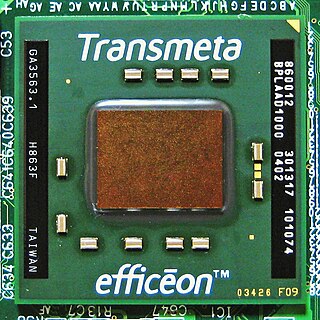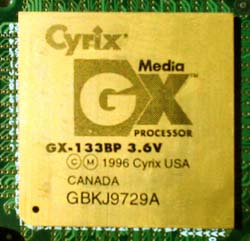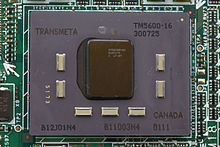
The Intel 386, originally released as 80386 and later renamed i386, is a 32-bit microprocessor designed by Intel. The first pre-production samples of the 386 were released to select developers in 1985, while mass production commenced in 1986. The processor was a significant evolution in the x86 architecture, extending a long line of processors that stretched back to the Intel 8008. The 386 was the central processing unit (CPU) of many workstations and high-end personal computers of the time. The 386 began to fall out of public use starting with the release of the i486 processor in 1989, while in embedded systems the 386 remained in widespread use until Intel finally discontinued it in 2007.

Itanium is a discontinued family of 64-bit Intel microprocessors that implement the Intel Itanium architecture. The Itanium architecture originated at Hewlett-Packard (HP), and was later jointly developed by HP and Intel. Launched in June 2001, Intel initially marketed the processors for enterprise servers and high-performance computing systems. In the concept phase, engineers said "we could run circles around PowerPC...we could kill the x86." Early predictions were that IA-64 would expand to the lower-end servers, supplanting Xeon, and eventually penetrate into the personal computers, eventually to supplant reduced instruction set computing (RISC) and complex instruction set computing (CISC) architectures for all general-purpose applications.
Very long instruction word (VLIW) refers to instruction set architectures that are designed to exploit instruction-level parallelism (ILP). A VLIW processor allows programs to explicitly specify instructions to execute in parallel, whereas conventional central processing units (CPUs) mostly allow programs to specify instructions to execute in sequence only. VLIW is intended to allow higher performance without the complexity inherent in some other designs.
In computing, Streaming SIMD Extensions (SSE) is a single instruction, multiple data (SIMD) instruction set extension to the x86 architecture, designed by Intel and introduced in 1999 in their Pentium III series of central processing units (CPUs) shortly after the appearance of Advanced Micro Devices (AMD's) 3DNow!. SSE contains 70 new instructions, most of which work on single precision floating-point data. SIMD instructions can greatly increase performance when exactly the same operations are to be performed on multiple data objects. Typical applications are digital signal processing and graphics processing.

Duron is a line of budget x86-compatible microprocessors manufactured by AMD and released on June 19, 2000. Duron was intended to be a lower-cost offering to complement AMD's then mainstream performance Athlon processor line, and it also competed with rival chipmaker Intel's Pentium III and Celeron processor offerings. The Duron brand name was retired in 2004, succeeded by the AMD's Sempron line of processors as their budget offering.

The Pentium II brand refers to Intel's sixth-generation microarchitecture ("P6") and x86-compatible microprocessors introduced on May 7, 1997. Containing 7.5 million transistors, the Pentium II featured an improved version of the first P6-generation core of the Pentium Pro, which contained 5.5 million transistors. However, its L2 cache subsystem was a downgrade when compared to the Pentium Pros. It is a single-core microprocessor.

The Pentium III brand refers to Intel's 32-bit x86 desktop and mobile CPUs based on the sixth-generation P6 microarchitecture introduced on February 28, 1999. The brand's initial processors were very similar to the earlier Pentium II-branded processors. The most notable differences were the addition of the Streaming SIMD Extensions (SSE) instruction set, and the introduction of a controversial serial number embedded in the chip during manufacturing. The Pentium III is also a single-core processor.
Transmeta Corporation was an American fabless semiconductor company based in Santa Clara, California. It developed low power x86 compatible microprocessors based on a VLIW core and a software layer called Code Morphing Software.

The Athlon 64 is a ninth-generation, AMD64-architecture microprocessor produced by Advanced Micro Devices (AMD), released on September 23, 2003. It is the third processor to bear the name Athlon, and the immediate successor to the Athlon XP. The Athlon 64 was the second processor to implement the AMD64 architecture and the first 64-bit processor targeted at the average consumer. Variants of the Athlon 64 have been produced for Socket 754, Socket 939, Socket 940, and Socket AM2. It was AMD's primary consumer CPU, and primarily competed with Intel's Pentium 4, especially the Prescott and Cedar Mill core revisions.
In computing, binary translation is a form of binary recompilation where sequences of instructions are translated from a source instruction set to the target instruction set. In some cases such as instruction set simulation, the target instruction set may be the same as the source instruction set, providing testing and debugging features such as instruction trace, conditional breakpoints and hot spot detection.

The K6-III was an x86 microprocessor line manufactured by AMD that launched on February 22, 1999. The launch consisted of both 400 and 450 MHz models and was based on the preceding K6-2 architecture. Its improved 256 KB on-chip L2 cache gave it significant improvements in system performance over its predecessor the K6-2. The K6-III was the last processor officially released for desktop Socket 7 systems, however later mobile K6-III+ and K6-2+ processors could be run unofficially in certain socket 7 motherboards if an updated BIOS was made available for a given board. The Pentium III processor from Intel launched 6 days later.
SSE2 is one of the Intel SIMD processor supplementary instruction sets introduced by Intel with the initial version of the Pentium 4 in 2000. SSE2 instructions allow the use of XMM (SIMD) registers on x86 instruction set architecture processors. These register can load up to 128 bits of data and perform instructions, such as vector addition and multiplication, simultaneously.

The Efficeon processor is Transmeta's second-generation 256-bit VLIW design released in 2004 which employs a software engine Code Morphing Software (CMS) to convert code written for x86 processors to the native instruction set of the chip. Like its predecessor, the Transmeta Crusoe, Efficeon stresses computational efficiency, low power consumption, and a low thermal footprint.
The AMD Family 10h, or K10, is a microprocessor microarchitecture by AMD based on the K8 microarchitecture. The first third-generation Opteron products for servers were launched on September 10, 2007, with the Phenom processors for desktops following and launching on November 11, 2007 as the immediate successors to the K8 series of processors.
x87 is a floating-point-related subset of the x86 architecture instruction set. It originated as an extension of the 8086 instruction set in the form of optional floating-point coprocessors that work in tandem with corresponding x86 CPUs. These microchips have names ending in "87". This is also known as the NPX. Like other extensions to the basic instruction set, x87 instructions are not strictly needed to construct working programs, but provide hardware and microcode implementations of common numerical tasks, allowing these tasks to be performed much faster than corresponding machine code routines can. The x87 instruction set includes instructions for basic floating-point operations such as addition, subtraction and comparison, but also for more complex numerical operations, such as the computation of the tangent function and its inverse, for example.

The MediaGX CPU is an x86-compatible processor that was designed by Cyrix and manufactured by National Semiconductor following the two companies' merger. It was introduced in 1997. The core is based on the integration of the Cyrix Cx5x86 CPU core with hardware to process video and audio output. Following the buyout of Cyrix by National Semiconductor and the sale of the Cyrix name and trademarks to VIA Technologies, the core was developed by National Semiconductor into the Geode line of processors, which was subsequently sold to Advanced Micro Devices.

The VIA Nano is a 64-bit CPU for personal computers. The VIA Nano was released by VIA Technologies in 2008 after five years of development by its CPU division, Centaur Technology. This new Isaiah 64-bit architecture was designed from scratch, unveiled on 24 January 2008, and launched on 29 May, including low-voltage variants and the Nano brand name. The processor supports a number of VIA-specific x86 extensions designed to boost efficiency in low-power appliances.
The Elbrus 2000 is a Russian 512-bit wide VLIW microprocessor developed by Moscow Center of SPARC Technologies (MCST) and fabricated by TSMC.












